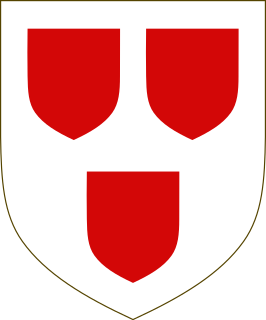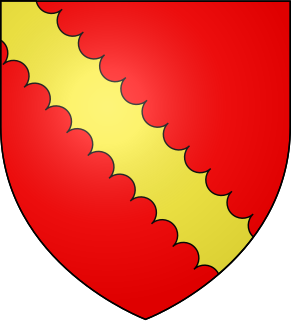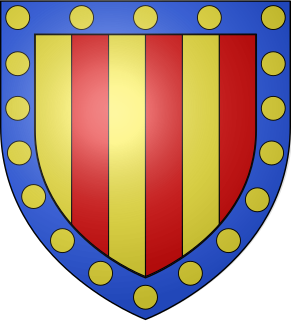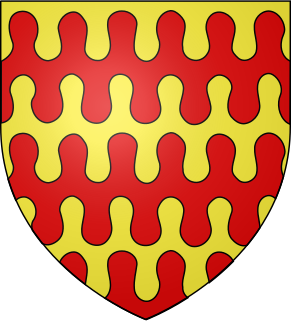
The Battle of Bannockburn on 23 and 24 June 1314 was a victory of the army of King of Scots Robert the Bruce over the army of King Edward II of England in the First War of Scottish Independence. Although it did not bring an end to the war, as victory would only be secured 14 years later, Bannockburn is still a major landmark in Scottish history.

Bannockburn is a town immediately south of the city of Stirling in Scotland. It is named after the Bannock Burn, a burn running through the town before flowing into the River Forth.
Earl of Clare was a title of British nobility created three times: once each in the peerages of England, Great Britain and Ireland.

Clan Hay is a Scottish clan that has played an important part in the history and politics of Scotland. Members of the clan are to be found in most parts of Scotland and in many other parts of the world. However, the North East of Scotland, i.e. Aberdeenshire (historic), Banffshire, Morayshire and Nairnshire Nairn (boundaries), is the heart of Hay country with other significant concentrations of Hays being found in Perthshire, especially around Perth, in the Scottish Borders, and in Shetland.
Walter Stewart was the 6th Hereditary High Steward of Scotland and was the father of King Robert II of Scotland, the first Stewart monarch.

Thomas de Berkeley, 1st Baron Berkeley, The Wise, feudal baron of Berkeley, of Berkeley Castle in Gloucestershire, England, was a peer, soldier and diplomat. His epithet, and that of each previous and subsequent head of his family, was coined by John Smyth of Nibley (d.1641), steward of the Berkeley estates, the biographer of the family and author of "Lives of the Berkeleys".
Events from the 1310s in England.

Sir Robert Keith was a Scottish knight, diplomat, and hereditary Marischal of Scotland who commanded forces loyal to Robert Bruce at the Battle of Bannockburn.

Sir Gilbert de la Hay, fifth feudal baron of Errol in Gowrie, was Lord High Constable of Scotland from 1309.
Mary Bruce was the younger sister of Robert the Bruce, King of Scots. During the First War of Scottish Independence, she was captured by the English and imprisoned in a cage at Roxburgh Castle for about four years. She was the daughter of Robert de Brus, 6th Lord of Annandale, and Marjorie, Countess of Carrick.
Sir Philip Mowbray or Philip de Mowbray was a Scottish noble who opposed Robert the Bruce in the Wars of Scottish Independence. He later changed his allegiance to Scotland and was killed in 1318 fighting in Ireland.
John Comyn IV, Lord of Badenoch was the son of John III "The Red" Comyn, former leader of Scottish rebels against the English, who was killed by Robert the Bruce in the Greyfriars church in Dumfries on 10 February 1306. He was sent to England after his father's death by his mother Jeanne de Valence.
Sir Edmund Comyn of Kilbride was a 13th-14th century Scottish noble. He was a younger son of William Comyn of Kilbride and Euphemia de Clavering.
Baron Vesci was a title in the Peerage of England and Peerage of the United Kingdom. It existed as a feudal barony by tenure, before being created by Writ of summons to Parliament of John de Vesci in 1264 until his death in 1289. It was created a second time by writ of William de Vescy in 1295 until his death in 1297. It was created a third time in 1313 by writ of William de Vesci until his death in 1314. The title was created a fourth time by writ of Henry Bromflete, Lord Vescy in 1449 until it became extinct in 1469 upon his death. The title was created a fifth time for John Vesey, 4th Viscount de Vesci in 1884 until his death in 1903 when the title became extinct.

Richard Grey, 2nd Baron Grey of Codnor, of Codnor Castle, was an English soldier and diplomat.
Edmund Hastings, 1st Baron Hastings, Lord of Inchmahome, was an Anglo-Scottish noble. He served as Governor of Perth, Governor of Berwick, Constable of Dundee and Sheriff of Berwick. He was killed during the Battle of Bannockburn against the Scots on 23 or 24 June 1314.

William Marshal, Lord of Hingham, was an English noble. He was hereditary Earl Marshal of Ireland and was slain during the Battle of Bannockburn, Scotland in 1314.

Richard Basset, 1st Baron Basset, Lord of Weldon, was an English noble.

Thomas de Ufford, Lord of Wrentham, was an English noble. He was killed during the Battle of Bannockburn against the Scots on 23 or 24 June 1314.

John Lovel, 2nd Baron Lovel, Lord of Titchmarsh, was an English noble. He was killed during the Battle of Bannockburn against the Scots on 23 or 24 June 1314.










